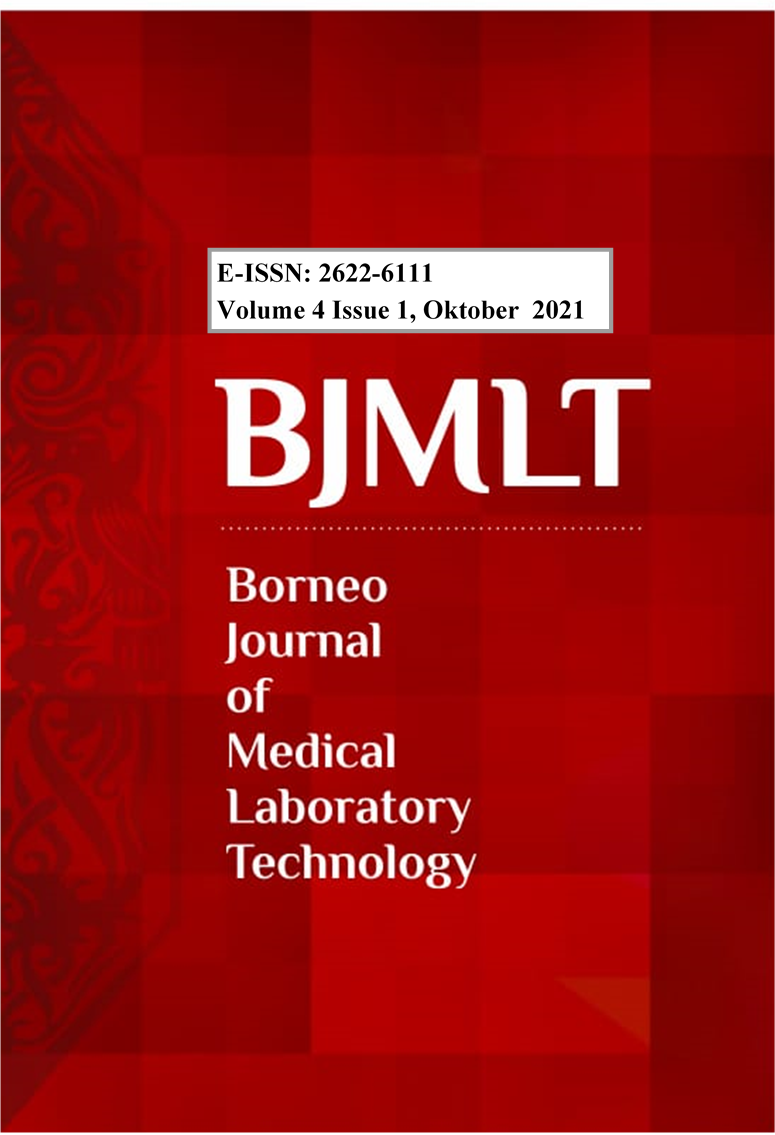Correlation Of Erythrocyte Sedimentation Rate (ESR) and Lymphocyte Counts in Pulmonary Tuberculosis Patients during Intensive Treatment in Purwokerto City Hubungan Nilai Laju Endap Darah (LED) dengan Jumlah Limfosit pada Pasien Tuberkulosis Paru Masa Pengobatan Tahap Intensif di Kota Purwokerto
Main Article Content
Abstract
Pulmonary tuberculosis is a disease caused by the bacterium Mycobacterium tuberculosis which most often attacks the lungs by spreading through the air in patients who cough, sneeze or spit. In tuberculosis, the erythrocyte sedimentation rate examination is used to help diagnose the course of the disease and help for the success of chronic therapy, and the examination of the lymphocyte count is used to support the diagnosis of bacterial infection. This study is an analytic study through a cross-sectional approach with the Pearson Correlation test. The results of this LED examination were 8 samples (21%) normal and 30 samples (79%) abnormal. On examination of the lymphocyte count, 21 samples (55%) had lymphopenia, 16 samples (42%) were normal patients, and 1 sample (3%) had lymphocytosis. In the Pearson correlation test, the correlation is unidirectional but moderately or moderately correlated (r=0.304). Based on these results, it can be concluded that there is a relationship between erythrocyte sedimentation rate and lymphocyte count. This means that if the LED value is large, the number of lymphocytes will also increase.
Downloads
Article Details
All rights reserved. This publication may be reproduced, stored in a retrieval system, or transmitted in any form or by any means, electronic, mechanical, photocopying, recording.
References
Bella Angkasawati.2018. Gambaran Jumlah Leukosit Pada Pasien Tuberkulosis paru yang mendapat terapi obat anti tuberkulosis (OAT) di RS Khusus Paru Provinsi Sumatera Selatan Tahun 2018. Palembang : Poltekkes kemenkes Palembang.
Departemen Kesehatan Republik Indonesia. Pedoman nasional: Penanggulangan Tuberkulosis. Cetakan ke-2. Jakarta: DepkesRI. 2011.
Dinas Kesehatan Jawa Tengah. (2018). profil kesehatan jawa tengah 2018. In jaJournal of Visual Languages & Computing.
Gandasoebrata R. 2007. Penuntun Laboratorium Klinik. Dian Rakyat, Jakarta.
Gandasoebrata, R, 2010. Penuntun Laboratorium Klinik, cetakan ke-16, Jakarta : Dian rakyat
Hartini Sri. 2014. Pemeriksaan Laju Endap Darah Pada Pasien Tuberculosis Paru. Jurnal Universitas Nahdlatul Ulama Sumatera Utara, Medan.
Lestari, Widya, 2017. Profil Laju Endap Darah Pada Pasien Tuberkulosis Paru Kasus Baru di RSU Tanggerang Selatan. Jakarta : Universitas Islam Negeri Syarif Hidayatullah.
Maelani, T., & Cahyati, W. H. (2018). Karakteristik Penderita, Efek Samping Obat dan Putus Berobat Tuberkulosis Paru. Higeia Journal of Public Health Research and Development.
Oehadian, Amaylia. 2003. Aspek Hematologi Tuberkulosis. Bandung : Fakultas Kedokteran Universitas Padjajaran.
Pratiwi, dkk. 2016. Hubungan Lama Penggunaan Obat Anti Tuberkulosis Dengan Efek Samping Pada Pasien TB MDR Rawat Jalan Di RSUP Sanglah Denpasar. Universitas Udayana Bali.
Riswanto. 2013. Pemeriksaan Laboratorium Hematologi. Alfamedika dan Kanal Medika. Yogyakarta. Pusat data dan informasi Kemenkes RI. Infodatin Tuberkulosis.2018. Jakarta.
Rizkiyani, Novita. 2017. Pemeriksaan Laju Endap Darah metode Westergren menggunakan Natrium Sitrat 3,8 % dan EDTA Yang ditambah NaCl 0,85 %. Stikes Insan Cendikia Medika Jombang.
WHO.Tuberculosis. 2006.New York: WHO Media Centre;
Zasshi, Kansenshogaku. Perpustakaan Nasional Kedoktekan Amerika. Institus Kesehatan Nasional; 1996. 955 p. Diakses dari : https://www.ncbi.nlm.nih.gov/pubmed/8921679.
